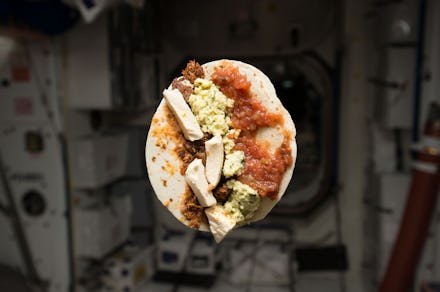Astronaut food and the diet of an average college kid are more similar than you'd think?

Country Time powdered lemonade, Triscuits and Lorna Doone shortbread cookies might sound like the make-shift dorm room dinner of a college kid, but the items are also diet staples for NASA astronauts.
While space food might conjure up images of futuristic silver packets of freeze-dried ice cream and mystery meat, for the most part, astronauts actually just eat things found on the shelves of earth's grocery stores.
It actually makes a lot of sense: The main requirement for space friendly foods is that are they are shelf stable and have a long shelf life, Bill Jeffs, a spokesperson for the NASA Johnson Space Center, said in an email. The foods shouldn't require any refrigeration at all, he added.
This means that astronauts consume a lot of granola, cornflakes, applesauce, dried beef, candy coated nuts, trail mix, pudding and thirst-quenchers like powdered fruit punch.
This is not to say that astronauts solely live on snack foods. Some meals are freeze-dried and thermostabilized (or heat processed so that they become shelf stable) so that they can be consumed in space. (Even cooler: NASA is experimenting with growing produce in space.)
Instead of being designed by chefs, NASA's meals are created by food scientists in the Space Food Systems Lab at Johnson Space Center in Houston, Jeffs said.
To date, the scientists have figured out how to make everything from scrambled eggs to tuna noodle casserole to cooked asparagus space friendly. Of all their options, the astronauts prefer shrimp cocktail, beef steak and a cherry-blueberry cobbler best, Jeffs said. All of the foods that are chosen for space are selected for their "commonality to everyday eating, the nutritional content and their applicability to use in space," NASA noted.
Foods are chosen for astronauts based on whether they'll hold up in a galaxy far, far away (or, you know, where the gravity is different). Consuming meals in microgravity can be quite challenging because foods float around and do not remain in one place. Because of this, foods with small particles — like salt — or crumbs are dangerous because they can foul up equipment and instruments, NASA noted. This is why all salt and pepper on space missions are only available in liquid form.
Houston, we have a problem
Cheesecake has yet to make it to space; so far, it's a mission that has proven to be impossible."We tried a thermostabilized cheese cake and gave up because the color was so poor (turned dark) after processing," Jeffs revealed.
As for variety in cuisine, there's not much of it way out there, the U.S. International Space Station Baseline Food List, which was emailed to Mic, reveals. A few dishes, including shrimp fried rice, teriyaki vegetables, crawfish étouffée and some mysterious vaguely Mexican dish called "fiesta chicken," as well as tacos somewhat step out of traditional American fare. But for the most part the astronaut diet is pretty heavy on foods resembling the type you'd find in a 1950s cookbook: Casseroles, pasta and meatloaf (that are thermostabilized) are all suited for space.
Why these are the most popular dishes is unclear. But, the meals are selected from a list months ahead of the mission by the astronauts themselves, NASA added.
And yet, American astronauts are living a life of culinary luxury compared to their brethren from other countries. According to Jeffs, only the U.S. and Russia have a dedicated organization making space foods. All other space agencies — including Canada's — have to "buy commercial off the shelf items to send for their crew members." Sorry Canadian astronauts, no space poutine for you.
While NASA's space foods aren't necessarily the picture of healthful, each dish is calibrated to help astronauts get enough nutrients. After an astronaut selects what they want on their meal plan, the menus are analyzed for their nutritional content by a NASA dietician, NASA noted. These dieticians then make recommendations to amend the menu to correct any nutrient deficiencies.
The diets of astronauts are also formulated to help them combat massive changes in their bodies. When in space, astronauts lose a lot of bone mass, Scientific American noted. They lose bone density at an average rate of 1 to 2% a month, while an elderly person on earth loses 1 to 2% each year, the publication added.
NASA doesn't provide astronauts with any vitamins except for a vitamin D supplement, Eater noted, so they must get all of their nutrients from their food in any way possible, from crackers to candy bars. That's the best excuse to eat a Milky Way while looking at the stars.